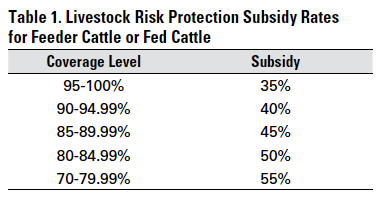Equip Your Service: Bagley Risk Management Insights
Equip Your Service: Bagley Risk Management Insights
Blog Article
Understanding Livestock Threat Defense (LRP) Insurance Policy: A Comprehensive Overview
Browsing the realm of animals danger security (LRP) insurance can be a complex undertaking for many in the farming field. This kind of insurance coverage uses a safeguard versus market variations and unexpected situations that could impact animals producers. By comprehending the intricacies of LRP insurance policy, producers can make enlightened decisions that might secure their procedures from economic risks. From how LRP insurance policy operates to the different protection alternatives offered, there is much to reveal in this comprehensive guide that might potentially shape the method animals manufacturers approach danger monitoring in their companies.

How LRP Insurance Functions
Sometimes, understanding the mechanics of Livestock Danger Security (LRP) insurance coverage can be complicated, yet breaking down how it works can offer clearness for farmers and ranchers. LRP insurance coverage is a danger administration device created to shield animals manufacturers versus unforeseen cost declines. It's essential to note that LRP insurance coverage is not an income assurance; rather, it focuses exclusively on rate risk protection.
Eligibility and Coverage Options
When it concerns insurance coverage alternatives, LRP insurance coverage supplies producers the adaptability to choose the coverage level, protection duration, and recommendations that ideal suit their danger monitoring demands. Coverage levels normally vary from 70% to 100% of the expected ending value of the insured animals. Manufacturers can also select insurance coverage periods that straighten with their manufacturing cycle, whether they are guaranteeing feeder livestock, fed cattle, swine, or lamb. Endorsements such as cost risk defense can additionally customize insurance coverage to protect against adverse market fluctuations. By recognizing the qualification requirements and protection alternatives offered, livestock manufacturers can make enlightened choices to take care of risk properly.
Advantages And Disadvantages of LRP Insurance
When assessing Livestock Danger Security (LRP) insurance coverage, it is essential for animals producers to evaluate the benefits and drawbacks inherent in this threat administration tool.

One of the primary advantages of LRP insurance policy is its ability to offer protection against a decline in animals prices. Additionally, LRP insurance policy provides a level of versatility, permitting producers to personalize coverage degrees and plan periods to match their certain needs.
One restriction of LRP insurance is that it does not secure against all kinds of risks, such as condition break outs or natural calamities. It is crucial for manufacturers to meticulously assess their private threat exposure and economic circumstance to determine if LRP insurance policy is the ideal threat monitoring tool for their operation.
Understanding LRP Insurance Policy Premiums

Tips for Making Best Use Of LRP Advantages
Optimizing the advantages of Livestock Danger Defense (LRP) insurance needs critical planning and proactive danger management - Bagley Risk Management. To make the most of your LRP protection, think about the following suggestions:
Consistently Assess Market Conditions: Remain informed regarding market patterns and cost changes in the livestock sector. By checking these variables, you can make educated choices regarding when to buy LRP protection to secure versus potential losses.
Set Realistic Protection Degrees: When selecting protection levels, consider your production expenses, market value of livestock, and potential threats - Bagley Risk Management. Establishing realistic insurance coverage degrees makes sure that you are effectively shielded without overpaying for unnecessary insurance
Expand Your Protection: Rather than relying solely on LRP insurance, think about diversifying your threat management strategies. Integrating LRP with various other risk monitoring tools such as futures agreements or options can give extensive protection against market uncertainties.
Evaluation and Adjust Insurance Coverage Regularly: As market problems change, occasionally evaluate your LRP coverage to ensure it aligns with your existing threat direct exposure. Readjusting insurance coverage degrees and timing of purchases can aid maximize your danger defense approach. By adhering to these tips, you can make the most of the advantages of LRP insurance and protect your livestock operation versus unanticipated risks.
Final Thought
Finally, animals danger defense (LRP) insurance coverage is a valuable device for farmers to take care of the financial threats linked my link with their livestock operations. By understanding exactly how LRP functions, qualification and coverage choices, along with the advantages and disadvantages of this insurance policy, farmers can make informed decisions to secure their incomes. By carefully considering LRP costs and carrying out methods to make best use of advantages, farmers can mitigate possible losses and make certain the sustainability of their operations.
Livestock manufacturers interested in getting Animals Threat Protection (LRP) insurance can explore a variety of eligibility requirements and protection options tailored to their particular livestock operations.When it comes to protection options, LRP insurance coverage visit site provides manufacturers the adaptability to pick the insurance coverage level, coverage period, and endorsements that finest suit their risk management needs.To comprehend the intricacies of Livestock Threat Security (LRP) insurance policy totally, recognizing the variables affecting LRP insurance coverage premiums is important. LRP insurance coverage premiums are identified by various elements, consisting of the insurance coverage degree selected, the expected price of livestock at the end of the insurance coverage duration, the type of animals being insured, and the length of the insurance coverage period.Review and Readjust Protection On a regular basis: As market conditions transform, regularly evaluate your LRP insurance coverage to guarantee it this straightens with your existing danger exposure.
Report this page